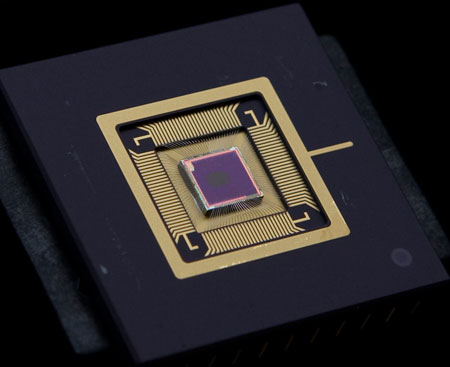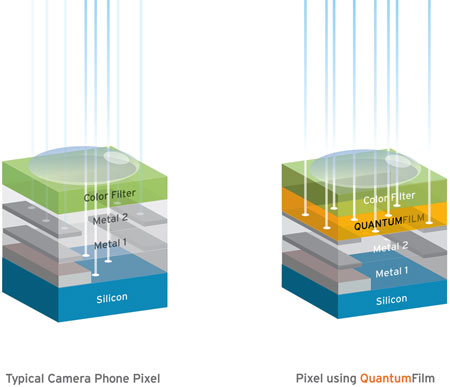
InVisage Technologies, a venture-backed startup, announced on Monday a technology in the field of digital photography.

Called “QuantumFilm,” it uses quantum dot-based image sensors instead of the more traditional silicon.
The new technology will offer four times the performance and twice the dynamic range as silicon, InVisage claims.
The company is targeting the cameras in smartphones first, and it claims its technology will bring professional photography features to these devices.
Scuttlebutt About QuantumFilm
QuantumFilm is based on quantum dots, which are semiconductors that capture light. Once the light is captured, the silicon beneath the dots reads out the image and turns it into a digital signal.
The quantum dot material is deposited directly on top of silicon wafers during manufacturing as a final wafer-level process. This makes for easy integration into standard semiconductor foundries.
QuantumFilm sensors will capture 90 to 95 percent of the light that comes in through a camera lens, whereas silicon-based image sensors only capture about 25 percent, Michael Hepp, director of marketing at InVisage, told TechNewsWorld.
Traditional silicon pixels have two problem areas, Hepp explained. One is that the circuitry’s on top of the silicon, which blocks some of the light from getting to the silicon for collection. The other is that silicon collects less light than quantum dots because it loses more energy than they do.
InVisage puts the sensors above the circuitry so they get more light.
The Dope on Dots
Understanding quantum dots is like taking a journey through hyperspace. You could get into the concept of excitons, which are quasiparticles consisting of a bound state of an electron, and an imaginary particle called an “electron hole” in insulators semiconductors and some liquids.
Or you could take the layman’s explanation — a quantum dot is a semiconductor whose conducting characteristics depend on the size and shape of the dot. Each dot is a crystal.
You can grow quantum dots by depositing a monocrystalline film on a monocrystalline substrate, or base layer. A monocrystalline film consists of one single crystal flattened out, with a crystal lattice that runs continuously and unbroken to its edges. Think of it as a ball of dough that’s been flattened out so it’s of uniform thickness and consistency.
Little about quantum dots is really new; it’s how the technology’s being applied that could be game-changing. Noted Soviet physicist Yakof Frenkel proposed the concept of excitons in 1932, for example, and scientists have been working with quantum dots for years.
“We didn’t just happen on this,” Hepp pointed out. “Ted had been working on this technology for over a decade.” He was referring to Ted Sargent, InVisage’s chief technology officer and founder, who’s a professor and Canada research chair in nanotechnology at the University of Toronto.
Time to Market

Initially, InVisage is targeting the smartphone market with its technology.
“The first targets will be the high-end smartphones,” Hepp said. InVisage is in talks with various smartphone manufacturers, he revealed. “Right now, we’re designing the product along with customers, and by year end, we’ll be sampling our product,” he explained.
InVisage should begin volume production in the second half of next year, he said, and finished products should hit retailers’ shelves shortly afterward. “We’ll probably see smartphones with our technology around Christmas 2011 or early 2012,” he said.
Changing the Digicam Game?
Whether or not quantum dot technology will revolutionize the market remains to be seen.
Smartphone customers will snap it up, according to InVisage’s Hepp. “Today, the way consumers understand smartphone camera quality is to look at the resolution,” he said. “Look at the iPhone — when Apple introduced the 3G with the same 2 MP (megapixel) camera as the 2G, it got a lot of bad press, and now the 3GS is a 3 MP device.”
On the other hand, perhaps the technology’s more suited to camera buffs. “I think InVisage is expecting too much of the consumer,” Carl Howe, director of anywhere research at the Yankee Group, told TechNewsWorld. “I’d expect it to be more important to professional photographers.”
Still, he conceded, you can’t rule out the consumer. “This is one of those things where it’s just a proof of concept now, and we don’t know how it’ll be commercialized,” Howe pointed out. “But anything that makes images better will end up in cameras and all kinds of other devices.”





















































